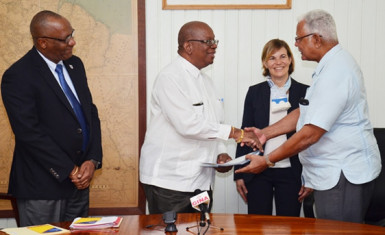The Guyana Government on Wednesday signed a US$3M agreement to rehabilitate the Cunha Canal, a key drainage mechanism on the East Bank of Demerara which has been operating significantly under capacity.
Part of the country’s Low Carbon Development Strategy’s adaptation initiatives, the grant to Guyana is being provided by the Norwegian Govern-ment under the Guyana REDD+ Investment Fund (GRIF), in partnership with the World Bank. The World Bank is one of the agencies designated to disburse project funds under the Norway pact.
The proposal for funding the Cunha Canal work had been floated with GRIF since 2012.
GINA said that the project is an important intervention which addresses adaption to climate change and the works will improve government’s ability to manage water from the East Demerara Water Conser-vancy (EDWC).

According to GINA, the proposed physical works for the Cunha Canal will include its widening, rehabilitation of the former outlet structure, re-routing the canal to re-establish its original alignment, and construction of a bridge on the East Bank of Demerara public road where the canal intersects the road. Rehabilita-tion of the canal will expand its discharge capacity and contribute to reducing the risks of the EDWC embankment overtopping.
Minister of Finance Winston Jordan said the project represents one small column in the way of greening the economy.
Speaking about flooding, GINA reported him as saying “While we look at a longer term option, we need to bring immediate relief to the citizens and businesses and property… I view this project in that context”.
He added “We’re happy that farmers and various aspects of the population and businesses that cover this wide area that the canal traverses will have some level of relief being brought to them, and I hope in the context of further interventions, both from GRIF and the World Bank, that together these can mitigate the effects over time of climate change on Guyana’s economy”.
GINA said that while the project was signed by the Minister of Finance it was handed over to Minister of Agriculture, Noel Holder as his ministry will be executing works under supervision by the Office of Climate Change and the Ministry of the Presidency.

Sophie Sirtaine, World Bank’s Country Director, Caribbean Country Management Unit Latin America and the Caribbean Region, said that the project would be extremely useful for Guyana.
“Your susceptibility to climate risk is exceptionally high especially in the coastal areas, therefore the rehabilitation of the canal is a very laudable endeavour that the government is embarking upon with us (World Bank)… It’s helpful not only because it supports the economy but ….it is also extremely helpful for the wellbeing of the population,” Sirtaine was quoted by GINA as saying.
In January 2012, Stabroek News had reported that the rehabilitation of the Cunha canal had been added to the list of projects to be funded with money garnered through Guyana’s forest agreement with Norway.
The Cunha canal which discharges into the Demerara River from the EDWC has not been working at its maximum capacity for a number of years. Limited capacity had been restored following the disastrous 2005 floods after the canal fell into disuse in 1990. The EDWC serves the functions of a flood control structure and a source of irrigation for agricultural lands during the dry season. The floods of 2005 had resulted in overtopping of the conservancy and prompted action by government to upgrade and strengthen the structure through a number of projects.
In 2009, then Agriculture Minister, Robert Persaud had told Stabroek News that improving the Cunha canal had been identified as a priority and that it would take US$1.5 million to complete. He had disclosed that funding was being sought from the World Bank which was working with the UK Department for International Development on finding resources for the project. That project apparently fell through. He had also announced that the proposed work would help to significantly drain the EDWC into the Demerara River. At that time, Persaud had said that Cunha, which drains through lands leased to Barama Company Ltd, was operating at 40 per cent of its capacity.
In a 2012 brief for the project to the GRIF, the government said that the Cunha Canal Rehabilitation Project is an important intervention addressing the focus area of adapting to climate change. The works will improve the ability of the government to manage water resources in the EDWC and protect Georgetown and surrounding areas from the impacts of climate change, the brief said.
“The Cunha Canal is located on the western side of the EDWC and discharges into the Demerara River. Around 1990, the canal was diverted from its original alignment to a smaller discharge channel.
“This diversion reduced the discharge capacity of the canal and went into disuse soon afterwards. The discharge through the canal was re-established during the 2005 flood but with a limited capacity as it is affected by circuitous routing, structural limitations and development between the East Bank Demerara (EBD) Public Road and the Demerara River. Rehabilitation of the canal will result in a more efficient functioning of the discharge system,” the brief said.




